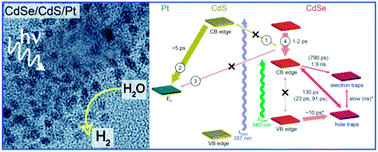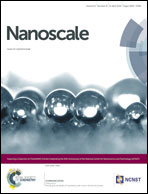Double heterojunction nanowire photocatalysts for hydrogen generation†
Abstract
Charge separation and charge transfer across interfaces are key aspects in the design of efficient photocatalysts for solar energy conversion. In this study, we investigate the hydrogen generating capabilities and underlying photophysics of nanostructured photocatalysts based on CdSe nanowires (NWs). Systems studied include CdSe, CdSe/CdS core/shell nanowires and their Pt nanoparticle-decorated counterparts. Femtosecond transient differential absorption measurements reveal how semiconductor/semiconductor and metal/semiconductor heterojunctions affect the charge separation and hydrogen generation efficiencies of these hybrid photocatalysts. In turn, we unravel the role of surface passivation, charge separation at semiconductor interfaces and charge transfer to metal co-catalysts in determining photocatalytic H2 generation efficiencies. This allows us to rationalize why Pt nanoparticle decorated CdSe/CdS NWs, a double heterojunction system, performs best with H2 generation rates of ∼434.29 ± 27.40 μmol h−1 g−1 under UV/Visible irradiation. In particular, we conclude that the CdS shell of this double heterojunction system serves two purposes. The first is to passivate CdSe NW surface defects, leading to long-lived charges at the CdSe/CdS interface capable of carrying out reduction chemistries. Upon photoexcitation, we also find that CdS selectively injects charges into Pt NPs, enabling simultaneous reduction chemistries at the Pt NP/solvent interface. Pt nanoparticle decorated CdSe/CdS NWs thus enable reduction chemistries at not one, but rather two interfaces, taking advantage of each junction's optimal catalytic activities.


 Please wait while we load your content...
Please wait while we load your content...